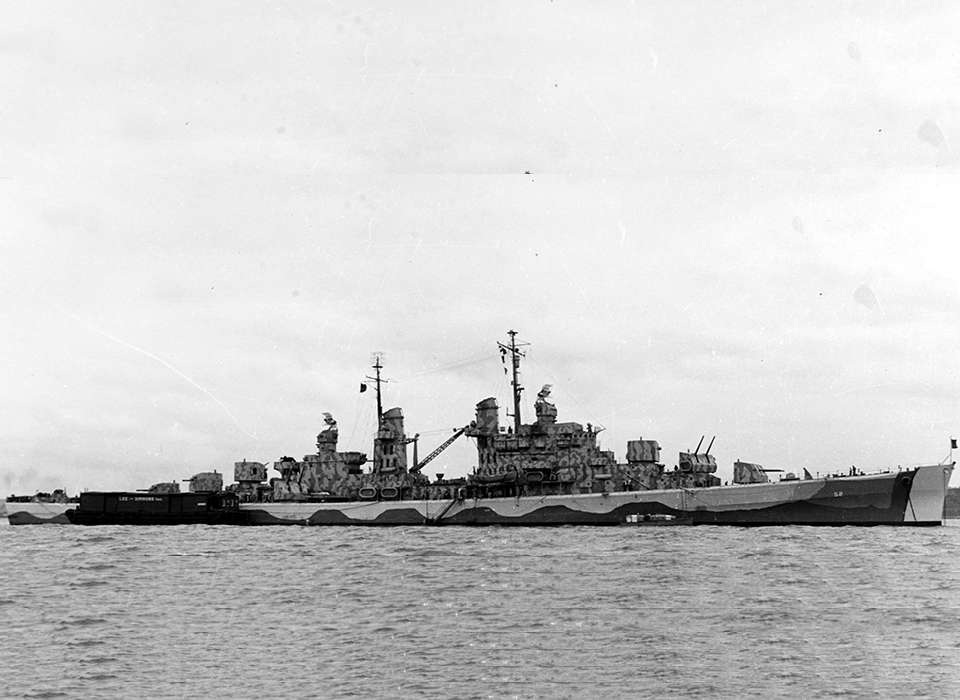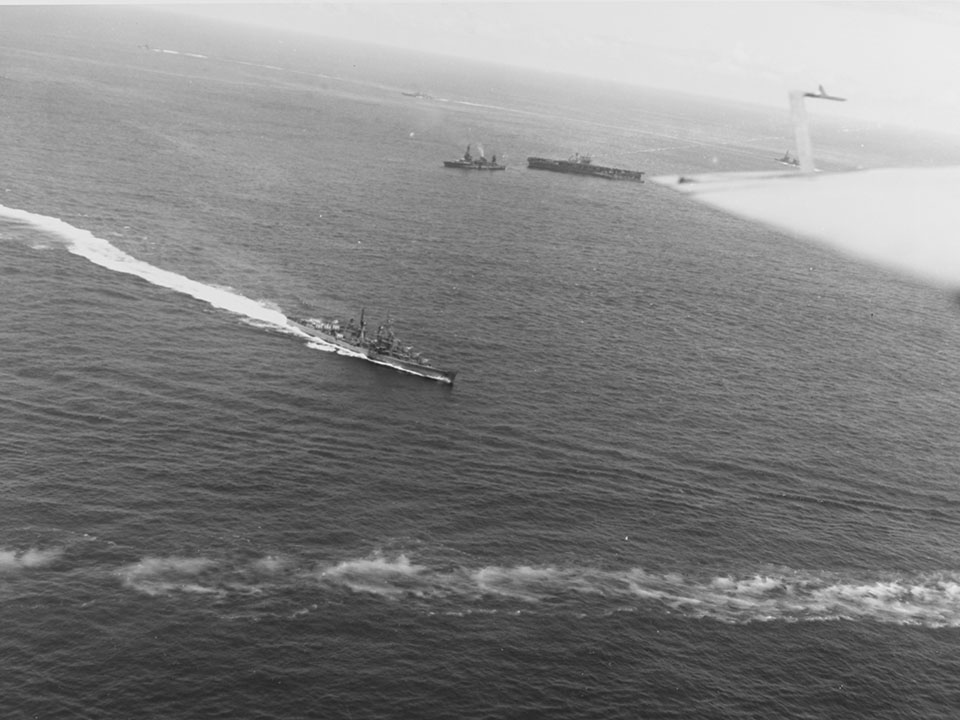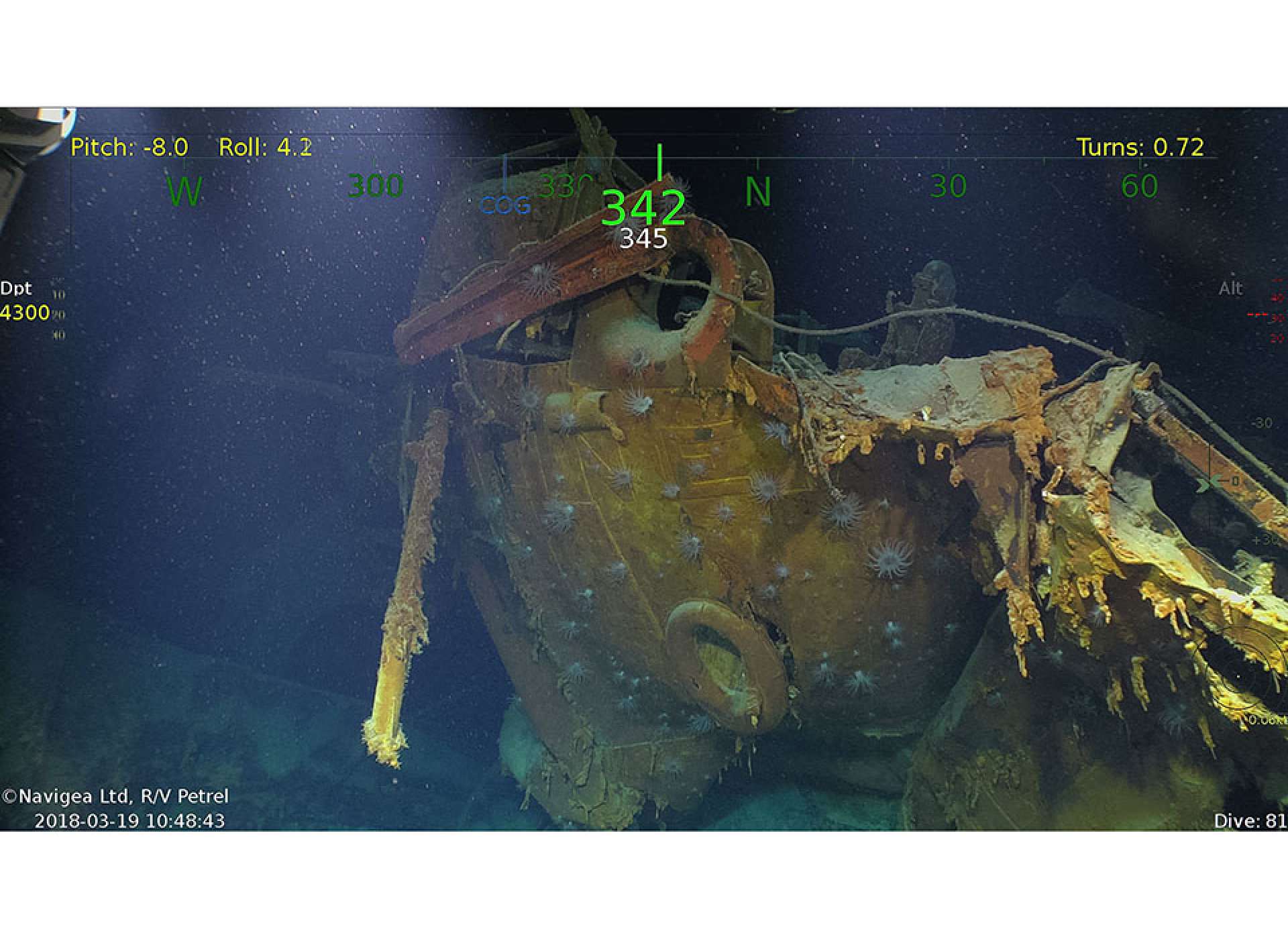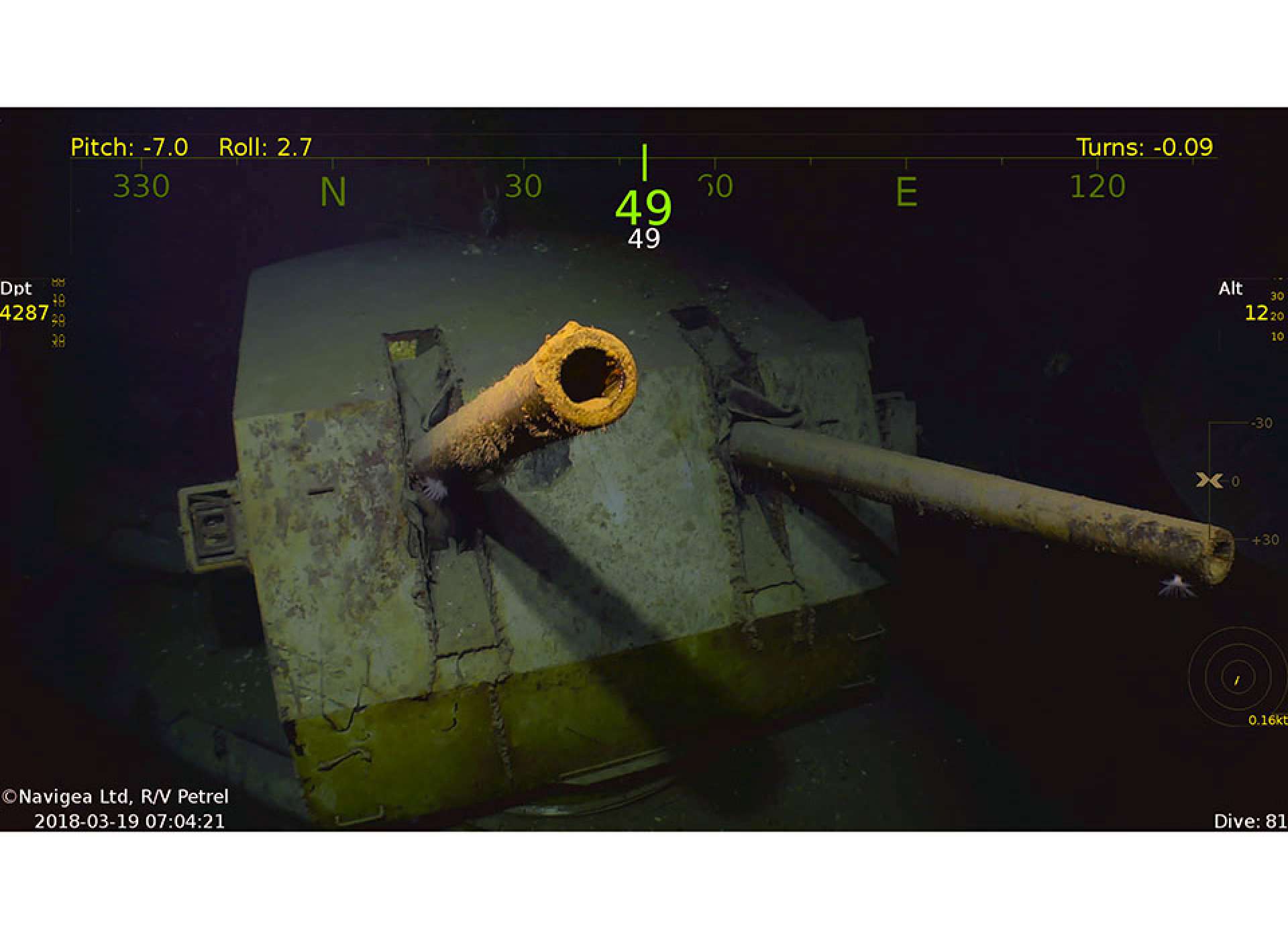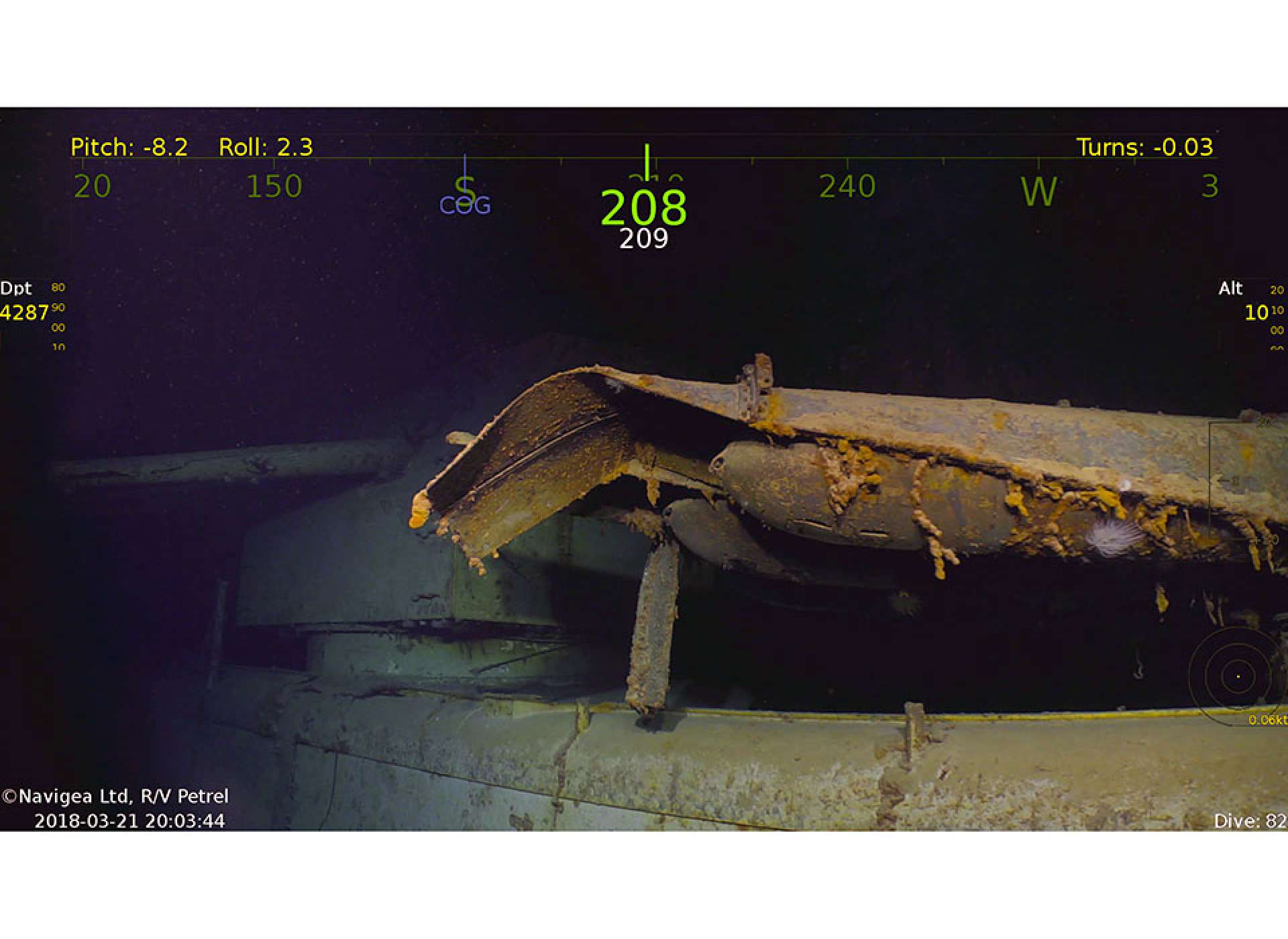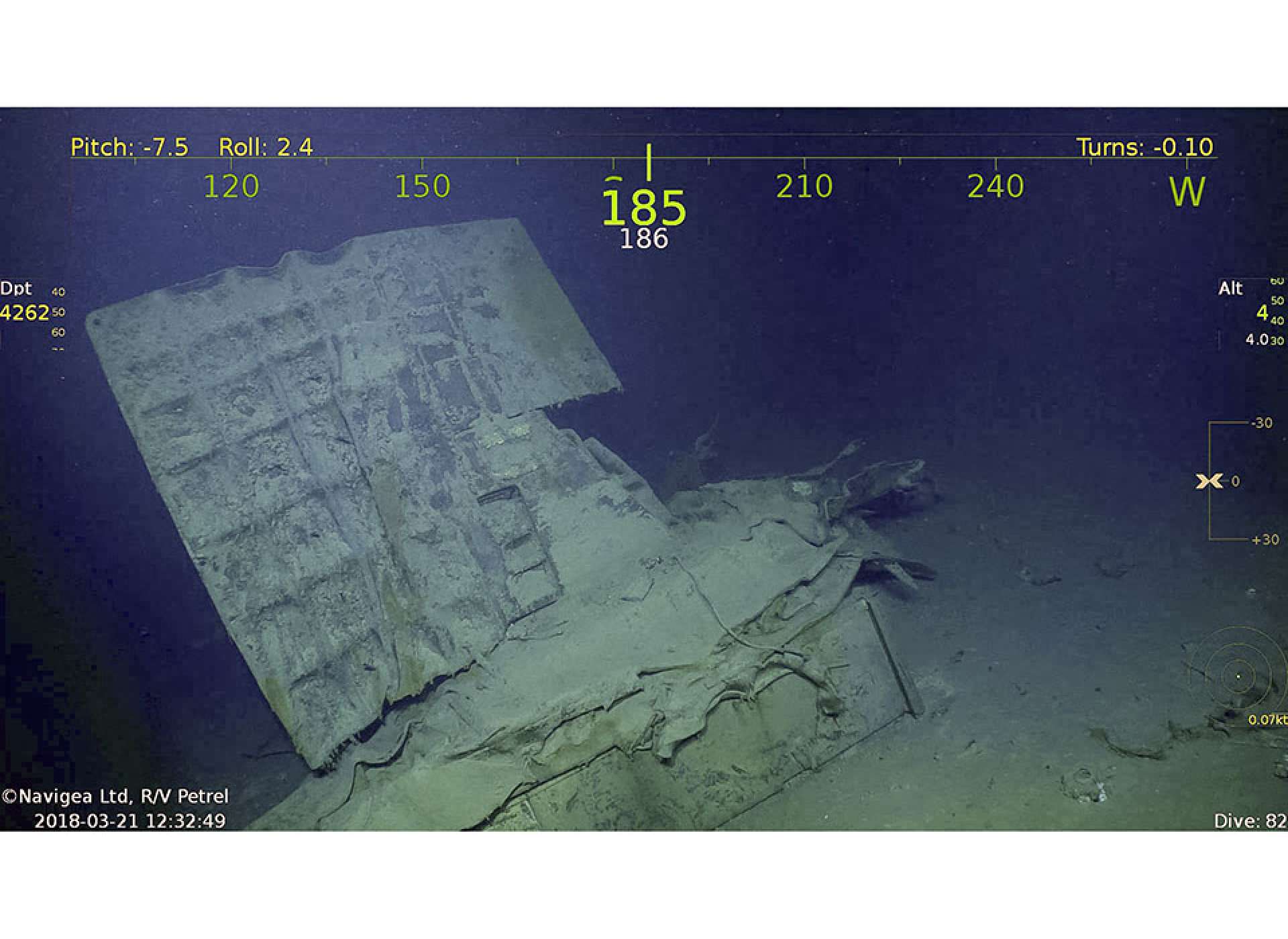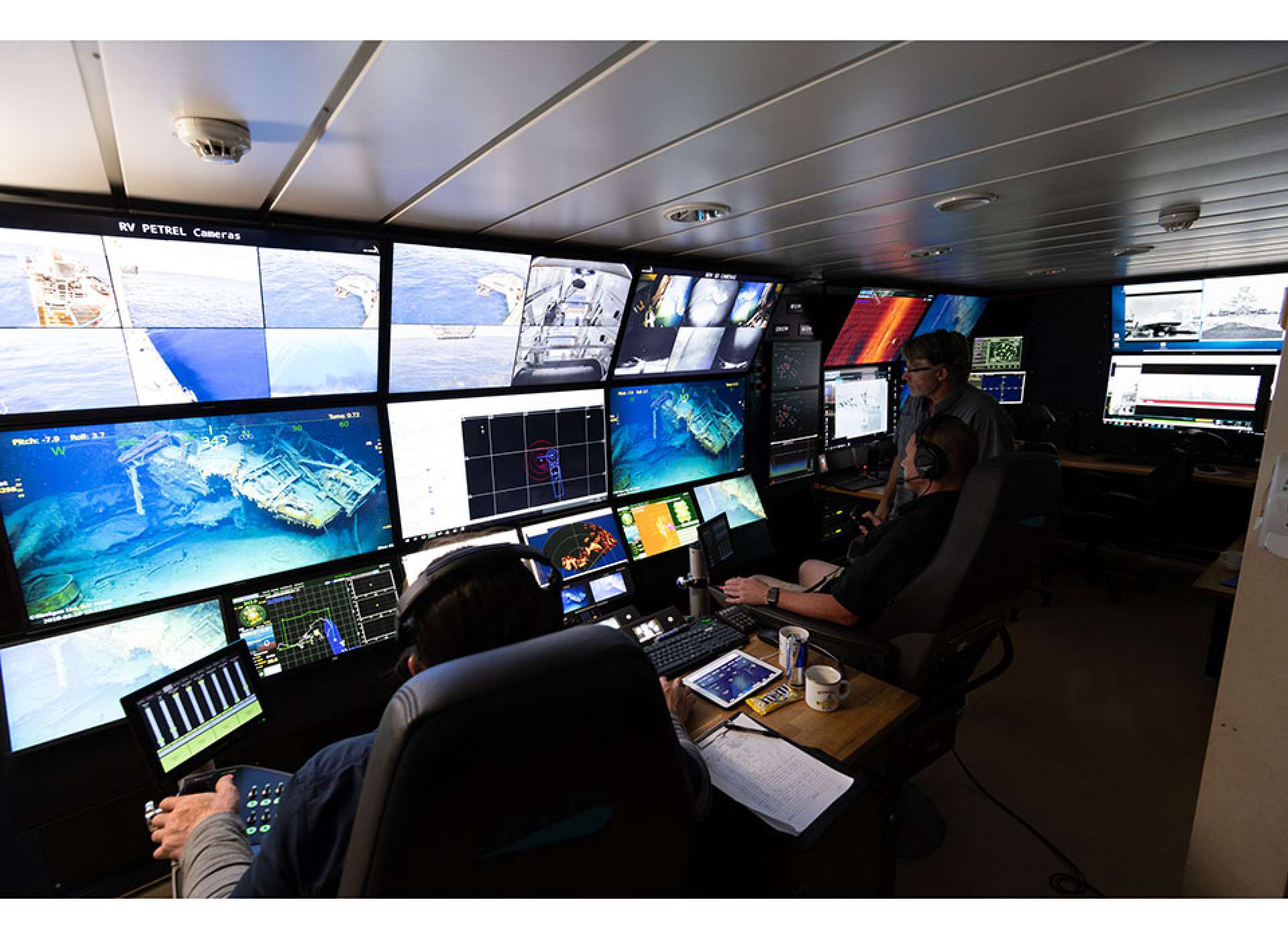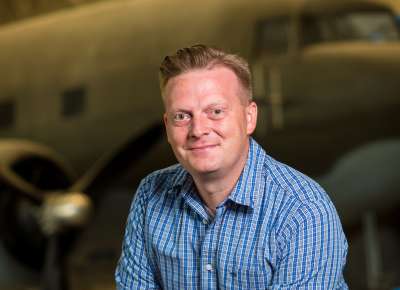Several thousand yards ahead of the cruiser, the sky was awash with searchlights, tracers and muzzle flashes exploding on the inky-black night sky like brilliant, violent lightning strikes. In the lead of the second column of American vessels, Seaman Allen Heyn sat in his 1.1 anti-aircraft mount and watched as the ships ahead shot each other to pieces. Through all the muzzle flashes Heyn could see that the Japanese ships were getting closer, yet his ship, the USS Juneau (CL-52) remained undetected, cruising along in the night, headed straight for the pyrotechnic show dead ahead.
In an instant, the black night became as bright as noon on a desert. A Japanese star shell exploded directly above Juneau and shone on the anti-aircraft cruiser from stem to stern. Juneau’s captain, Lyman Swenson wasted no time and ordered his gun crews to open fire. Juneau’s rapid-fire 5-inch gun turrets trained to port and opened fire on the nearest target. The nearest target to Juneau was the massive Japanese battleship Hiei, burning like a bonfire from all of the small caliber shell hits her superstructure had taken from the other American ships. Heyn and his fellow gunners opened fire on the massive Japanese battleship from close in. He later recalled, “We fired right into the topside of their ship trying to knock off some of their guns on their deck.” Further forward on Juneau, Joseph Hartney opened fire with his water-cooled .50 caliber machine gun, raking the battleship up and down with his weapon, attempting to kill as many enemy sailors as he could with his fire.
As Juneau cleared Hiei she began to pass the heavy cruiser San Francisco (CA-38). Radio transmission from San Francisco to Juneau indicated that the latter ship was blocking the former from firing a full broadside at an enemy target. Captain Swenson ordered flank speed, cut his ship across Frisco’s bow and took station on her port side. As Juneau slid into position, she and her larger friend San Francisco attracted the attention of the Japanese destroyer Murasame. The Japanese destroyer opened fire on Juneau, who answered in kind. The two ships traded shell fire briefly when Juneau was seemingly lifted out of the sea with a tremendous jolt. Murasame had fired a spread of torpedoes at San Francisco just before Juneau had taken station alongside her. A single torpedo meant for the American flagship struck Juneau nearly amidships, on the port side in the forward fire room.
The torpedo hit stunned Allen Heyn on Juneau’s stern. He recalled that, “all of us fellows that were on the main deck, it stunned us like, and knocked us down.” The damage caused by the torpedo hit on the lightly armored anti-aircraft cruiser was terrific. All control of Juneau’s gun turrets ceased, her steering was lost, her internal bulkheads near the detonation were crumpled, her deck was buckled. She took at 15-degree list to port and her keel had either been broken, or at the very least, severely fractured. Steering was restored quickly from aft control, and Captain Swenson ordered his severely damaged ship to break contact with the enemy and leave the scene of the still raging fight.
Dawn found Juneau limping along, down 12 feet by the bow but making 20 knots on a relatively calm sea. As the sun crept over the horizon, Juneau’s crew had re-established local control to a few of her gun turrets, patched some of the stress fractures in her seams, reduced her list to a paltry 2-degrees, and given Captain Swenson enough hope that he planned to make his way to the American base at Espiritu Santo for more stable repairs. Shortly after dawn, a column of ships was sighted ahead. Identification of the ships was confirmed as friendly, and Juneau eased into formation, slowed her speed to 10 knots, and took station alongside the cruiser Helena (CL-50).
As the task force limped along, alerts for enemy submarines and aircraft came and went, keeping the majority of Juneau’s crew at general quarters. Having been at “GQ” all night and into the morning, the sailors began to get used to it and began to calmed down after the wild night. Allen Heyn remembered that “It was kinda quiet and it was sort of a lull for a few minutes, and everybody was talking and breathing a little easy.” Heyn took over a fellow shipmate’s station on his gun, put the earphones on his head and heard a brief gurgle of a message over the phones when an enormous explosion threw him against the gun mount. As Heyn opened his eyes, he saw oil raining down on him and smoke boiling through the air. He felt the stern of the ship almost instantly begin to slide underneath him at an acute angle.
Moments before the explosion, lookouts aboard the San Francisco saw four white torpedo wakes streaking towards the heavily damaged flagship. The Japanese submarine I-26 had been stalking the battered task force for quite a while. She lined up on the biggest target, San Francisco, and fired a spread of torpedoes. For the second time in less than 24 hours, the Frisco’s luck with enemy torpedoes was with her. Lieutenant Commander Schonland aboard San Francisco ordered full right rudder, emergency ahead, as the big ship desperately veered away from the deadly torpedoes. Three of the torpedoes missed the cruiser while another passed directly underneath and shot out from her starboard side. The torpedo streaked directly at the ship that had just slid beside San Francisco a short time earlier. There simply was no time to warn Juneau of the incoming disaster. I-26’s torpedo struck Juneau in almost the exact same place the torpedo from Marusame had hit her earlier that morning. More than likely, the Japanese torpedo entered the same wound and exploded inside the vessel in her powder magazine. The resulting explosion was catastrophic.
A signalman aboard Helena was looking through binoculars at his counterpart aboard Juneau when the man simply disappeared. As he ripped the binoculars from his eyes, he could see Juneau’s signalman fly through the air as if he had been snatched by the hand of God.
Where seconds before a 541-foot-long cruiser had been, there now was nothing but an enormous cloud of smoke and debris. Juneau disappeared from view and sank in less than 20 seconds.
Captain Gilbert Hoover aboard Helena witnessed the massive explosion and assumed that there was simply no way that anyone could have survived. Knowing full well that an enemy submarine was in the area, and not wanting to risk anymore of his heavily damaged ships, he ordered the task force to continue on, and not look for any survivors from Juneau. But what Captain Hoover assumed to be a loss of all hands aboard Juneau, was not the case. Not at all. While the tremendous explosion killed a great many of the crew instantly—including three of the five Sullivan brothers, Frank, Joe and Matt—over 100 survivors bobbed on the ocean’s surface as the American task force sailed away over the horizon.
Allen Heyn felt the suction of the ship grab him and pull him down. He later recalled, “I just gave up. I thought there wasn’t a chance at all. Everything just ran through my head.” Heyn’s foot was sandwiched in a piece of his ship’s gun mount, the heavy steel dragging him deeper and deeper. Suddenly, he felt his foot release, and the kapok life jacket he had grabbed seconds before being dragged under shot him to the surface. As he cleared the surface of the ocean and the several inch-thick layer of oil from Juneau’s fuel tanks, he looked around for other survivors, and saw none. After a brief time, he began to hear men yelling, some crying, and some screaming in pain. Fellow shipmates began to pop up on the surface. Like Heyn, they too had been dragged under by the sinking ship, only to be shot to the surface by some miracle.
Frank Holmgren recalled years later, “The ship just blew up in my face. My hand landed on a life jacket. I sort of pulled it on me ... the ship was going down ... the fantail was at a 45-degree angle. I said ‘Oh my God, I’m gonna die; oh my God, I’m gonna die.’ Then I was gone.” Holmgren lost consciousness as he went deep beneath the surface, but like Heyn and many others, the ship lost its hold on him and he shot to the surface, where he regained consciousness almost instantly. Lester Zook popped to the surface and couldn’t see due to the thick layer of oil on his eyes. He heard someone holler for him to swim to him, which he did, and was pulled into a life raft. Like Zook, Allen Heyn grabbed on to a piece of debris and swam to a life ring floating in the water that was tied to three life rafts. The survivors began to gather together as quickly as they could for mutual protection, but at least two thirds of them were grievously wounded, including Al Sullivan, who survived the initial sinking but quickly died as a result of fatal wounds he suffered during the ship’s explosion.
A little over an hour after the sinking, a B-17 flew past the survivors, banked hard, and skimmed the surface so low that Allen Heyn could see the crewmen in the airplane wave at him. Heyn waved back, his hope for rescue buoyed knowing that the B-17 had seen the 100 or so survivors floating amidst the debris from Juneau. Heyn was sure that help would arrive soon. But as the hours turned into days, his hope began to slip away like so many of his fellow shipmates his hopes began to slip away.
The majority of the survivors had been wounded in the ship’s detonation, and as such suffered horrible injuries that attracted the attention of unwanted guests: sharks.
Nightfall would inevitably bring the predators, who snatched the wounded and dragged them below. By the third day, the sharks didn’t wait until nightfall to feed. The predators were swarming the survivors in broad daylight, grabbing anyone they could. Those who would swim away from the mutual protection of the rafts quickly fell to the threat lurking beneath the surface. A survivor would swim away, then those on the rafts would hear a blood-curdling scream, see the water thrash…and then all was silent. Until another shark took another survivor. One by one, the few became fewer.
Soon water, or lack thereof, became an issue. Some survivors swallowed the salt water of the sea, and grew delirious and out of their minds. They would tell the others that they could see the ship beneath the surface, break off from the rest, and swim below, only to vanish into the jaws of a dark shadow. Allen Heyn recalled how he shared a raft with the eldest Sullivan brother George, who was desperately calling out for his deceased kin and stricken by an inconsolable grief, and slowly losing his mind due to lack of water and shock. Four days after Juneau sank, George stripped off all his clothes, declared to Heyn that he was going below to take a bath, slipped off the raft and swam away. Heyn watched as George swam and suddenly disappeared: another victim of the sharks.
Nine days after Juneau was sunk, Allen Heyn, now the sole survivor on his life raft, was located by the destroyer USS Ballard (DD-267). Heyn was scooped up by the ship with a chunk taken out of his hip by a shark, but otherwise healthy and thirsty. Of the more than 100 survivors of Juneau’s sinking, Allen Heyn was among the ten who were rescued by the Navy.
The disaster of the Juneau was covered up by the Navy. Her sinking was announced after the victory at Guadalcanal had been secured, but the plight of her survivors wasn’t told until well after the war. The five Sullivan brothers from Waterloo, Iowa, their actual fates undisclosed, were turned into national heroes. The picture of their five smiling faces aboard Juneau on her commissioning day graced propaganda posters all across the United States. The Navy felt that an homage was due to the Sullivan brothers, so they commissioned a destroyer in their honor. On April 4, 1943 the USS The Sullivans (DD-537) was launched, with the brothers' mother Alleta christening the vessel built to honor her sons. Other survivors of the sinking were reassigned, and most saw further combat action in the Pacific.
The Juneau and the story of the Sullivan brothers became a national legend. Most students of the war have at least heard of the brothers, but not of their actual demise, nor that of their ship. The Juneau, like USS Indianapolis (CA-35), became part of the myth and memory of the war at sea in the Pacific. A ghostly memory of a bygone era, the last view of her was a boiling cloud of smoke and debris. That is, until St. Patrick’s Day, 2018.
Early in the morning of the feast day of the foremost patron saint of Ireland, RV Petrel and their team of undersea explorers and archaeologists located Juneau’s wreck site and the death site of the five Irish sons of Waterloo, Iowa. Lying some 13,000 feet beneath the surface of the Pacific, Juneau’s wreck is scattered across a wide debris field. The evidence of the cataclysmic explosion that sank her is clearly evident in the images Petrel’s ROV provided. Her stern section is lying next to her bow, while her midships section is nearly a kilometer away. Any doubt to her identity was washed away when her name appeared emblazoned across her stern in raised letters: JUNEAU. Thanks to the images provided by the crew of RV Petrel seeing her devastated wreck gives one pause. The steel on her intact portions is bent and twisted in violent angles, silent testimony to the ferocity of the explosion that literally evaporated a United States Navy cruiser. The devastating injuries sustained by those who survived is hard to imagine, yet when one sees her grave, one can appreciate the resilience and sheer determination of the gallant few who lived to tell her tale.
Photos by Paul G. Allen's Vulcan Inc.
-

Juneau's name emblazoned on her sunken stern.
-

One of Juneau's five-inch gun turrets still ready for action.
-

One of Juneau's gun turrets appears in the murky darkness.
-

Twisted wreckage from Juneau displays the violence of demise.
-

The crew of RV Petrel during the search and discovery of USS Juneau.
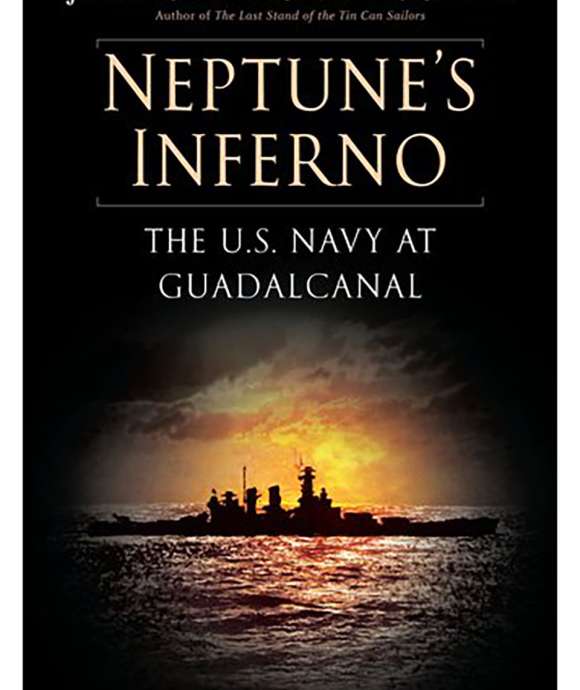
Neptune's Inferno
Working from new interviews with survivors, unpublished eyewitness accounts, and newly available documents, Hornfischer paints a vivid picture of the officers and enlisted men who took on the Japanese in America’s hour of need: the five Sullivan brothers, all killed in the shocking destruction of the Juneau; and many others, all vividly brought to life.
Seth Paridon
Seth Paridon was a staff historian at The National WWII Museum from 2005 to 2020. He began his career conducting oral histories and research for HBO’s miniseries The Pacific and holds the distinction of being the first historian hired by the Museum’s Research Department. In the 12 years he was Manager of Research Services, Seth and his team increased the oral history collection from 25 to nearly 5,000 oral histories.
Cite this article:
MLA Citation:
APA Citation:
Chicago Style Citation:
